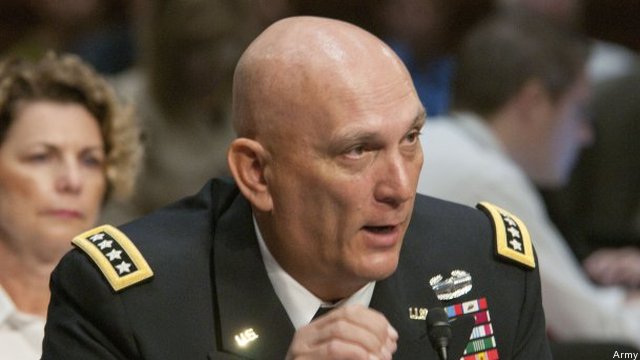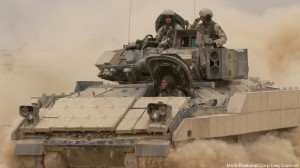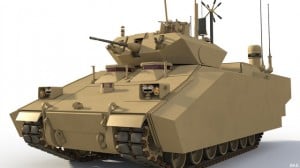The Feasible Four: Odierno Wants Army To Launch New Combat Vehicles
Posted on

Gen.Ray Odierno
WASHINGTON: “In the next two years,” Army chief of staff Ray Odierno said today, the service could move out on four new combat vehicles and reboot its aging inventory for a new era of war. They range from a parachute-droppable light truck for Airborne soldiers to a scout car, a light tank, and a new infantry fighting vehicle to carry heavy troops into the teeth of enemy fire.
These projects are more incremental than revolutionary, more modest than ambitious, but they’re a step beyond the variants of 1980s-vintage vehicles the Army is currently procuring. They don’t attempt to transform the Army like the cancelled Future Combat System or the Reagan buildup’s famed “Big Five” — but they might just be the Feasible Four.
The biggest challenge is the IFV, sometimes also called the Future Fighting Vehicle. This machine would replace the Cold War mainstay of the armored force, the M2 Bradley, which FCS and the Ground Combat Vehicle programs both failed to do.

M2 Bradley
“I think you’re going to see us do something here in the near term about the infantry fighting vehicle,” Gen. Odierno said this morning at a Defense Writers’ Group breakfast. “Something” means less than a full-up production program, but more than PowerPoint slides: Odierno’s talking physical prototypes of future vehicles.
“We’re taking a look at, do we move forward with some sort of prototyping? We’re still working our way through that,” Odierno said when I pressed for more detail. The idea, he said, is “we take what we’ve done so far [in analysis and on prior programs] and begin to move forward so we have a place to start from.”
One Hill staffer I spoke to was skeptical the Army was anywhere near ready to build prototype infantry fighting vehicles. “I think it’s way too early for prototyping, way too early,” the staffer said. “As far as I know there’s no urgency to field a new IFV. There never has been, [and] there’s no leap ahead in armor materials” that could make for a better-protected replacement for the Bradley that comes in at a reasonable weight.

Polaris DAGOR vehicle
In fact, of Odierno’s four, the vehicle closest to entering service is the lightest: The Ultra-Light Combat Vehicle (ULCV), essentially a rugged offroad truck, for which companies from giant General Dynamics to tiny Vyper Adamas are now competing. Based on extensive analysis of “early entry” scenarios where paratroopers precede the rest of the force, Odierno said, “when the Airborne gets on the ground we want to be able to move them very quickly somewhere, and they can’t necessarily do it walking.”
“We also realize that we need some kind of a light reconnaissance capability for them,” Odierno continued. That would be the Light Reconnaissance Vehicle, for which some of the same companies are already offering uparmored and upgunned versions of their ULCV entries.
The ULCV needs to carry nine infantrymen cross-country, while the LRV would carry six scouts, heavy weapons, and sensors. In both cases, the Army is clearly looking at off-the-shelf technology that’s good enough to go — two contenders are already in service with Special Operations Command — rather than a protracted development process to get a perfect vehicle — which is what went awry with FCS and GCV.
But some development work would be required for the next machine on the agenda, the Mobile Protected Firepower vehicle. That “is probably a mid/long-term solution,” Odierno said.
The technical challenge here is building a heavily armored and decently armored vehicle that’s still light enough to deploy by aircraft — or even drop by parachute — to support infantry forces before the heavy tanks can arrive. The Army has struggled to develop such a weapon since World War II, retiring the fragile M551 Sheridan light tank in 1996 and truncating production of the wonky Mobile Gun System. Unlike the ULCV transport and LRV scout, there’s no vehicle currently in production in the United States that could fit this bill.
Odierno also predicted developments on vertical lift — i.e. helicopters or whatever replaces them — and unmanned ground systems — i.e. robots. All told, he said, “I’m hoping that in the next two years you’re going to see some developments that really [are] based on this analysis we’ve done, where we’re going to really start to be able to identify, ‘this is exactly the kind of system we need to take us forward.'”
But how, asked a skeptical reporter, can the Army promise progress on so many systems when budgets are tight for all the services and the Army in particular has a terrible track record on procurement?
“It’s hard,” Odierno said bluntly. But, he insisted, the Army is infusing new rigor and realism into acquisitions.
The intellectual starting point is last fall’s Army Operating Concept, entitled Win In A Complex World, which laid out twenty “warfighting challenges” the service needed to solve. It was studying the “forcible and early entry” challenge (No. 12) that convinced Army leaders they needed the Ultra-Light Combat Vehicle, Light Reconnaissance Vehicle, and Mobile Protected Firepower vehicle.
What’s crucial about the concept and the challenges is that they force the Army’s rival tribes to work together. Each branch of the service has its own headquarters that handles training, doctrine, and requirements for new weapons: helicopters at Fort Rucker, intelligence at Fort Huachuca, artillery at Fort Sill, infantry and tanks at Fort Benning, and so on. Historically these “schoolhouses” guard their turf jealously and operate independently.
But under the new construct, “for the first time we’re not doing it in stovepipes,” Odierno said. “It’s not that the Maneuver Center at Benning is saying, ‘I need this vehicle.’ It is an integrated look across all of our branches and all of our centers of excellence… so I think we’re coming up with much better solutions.”
Part of “better” is not insisting on “best,” Odierno went on. “One of the problems we’ve had in the past with our major programs is we tried to build the perfect vehicle,” he said. Odierno didn’t give examples, but consider the Future Combat System, which tried to pack the fighting power of a 70-ton M1 tank into a 20-ton machine, or the Ground Combat Vehicle, whose protection requirements drove its growth to circa 70 tons.

BAE’s design for the cancelled Ground Combat Vehicle
“The requirements were so high, they were difficult to meet, took a long time, ended up being over budget, and sometimes we found out we couldn’t meet them” no matter how long or costly the development process, Odierno said. “Now…we’re developing requirements that leave room for improvement.” Instead of plodding towards perfection, he said, the Army needs to quickly field 80 percent solutions, then upgrade them incrementally to 90 percent and maybe someday 100.
To make the best trade-offs possible in this process, however, the Chief of Staff needs more authority over acquisitions, Odierno said. That’s a highly contentious proposition, but both the House and Senate now seem sympathetic to it. Both bodies have Odierno-approved language in their respective drafts of the National Defense Authorization Act.
“The legislation’s been put forward to get the service chiefs more involved. It’s really important, because I want to be involved with the trades,” he said. “[Currently], I can help develop requirements, but I don’t get involved in the trade space, and I think that’s where we can add a lot, is in the trade space and understanding this iterative process.”
“It’s not that I don’t have confidence in our [civilian] acquisition executives,” he said. “They do a great job, but I think there’s an experience and expertise…that the service chiefs can add to this.”
Odierno’s pushed this idea before, and there’s tremendous skepticism among several of our sources that the service chiefs will do anything with additional power besides screw more programs up. Likewise, one well-informed thinktank analyst doubted the Army’s new process will save the day: “My sense is that the ‘warfighting challenges’/requirements stuff is rearranging of deck chairs that they really want to believe is meaningful but isn’t.”
But the biggest barrier is the budget. “Even if it’s more affordable, it may not be affordable enough,” the analyst said.
Odierno himself acknowledged the money problem. “The only thing that will get us off track is if we continue to go down and have these budget issues,” he said. “That’s the biggest challenge in everything we’re doing.”
With the Budget Control Act on the books and various fixes in debate, “we have no predictability at all, and the lack of predictability is killing us, because it’s making everything even more expensive than it already is because we can’t properly plan,” Odierno said. If sequestration goes into full effect, he said, “it’s going to put us in a modernization hold for ten years.”
Subscribe to our newsletter
Promotions, new products and sales. Directly to your inbox.
